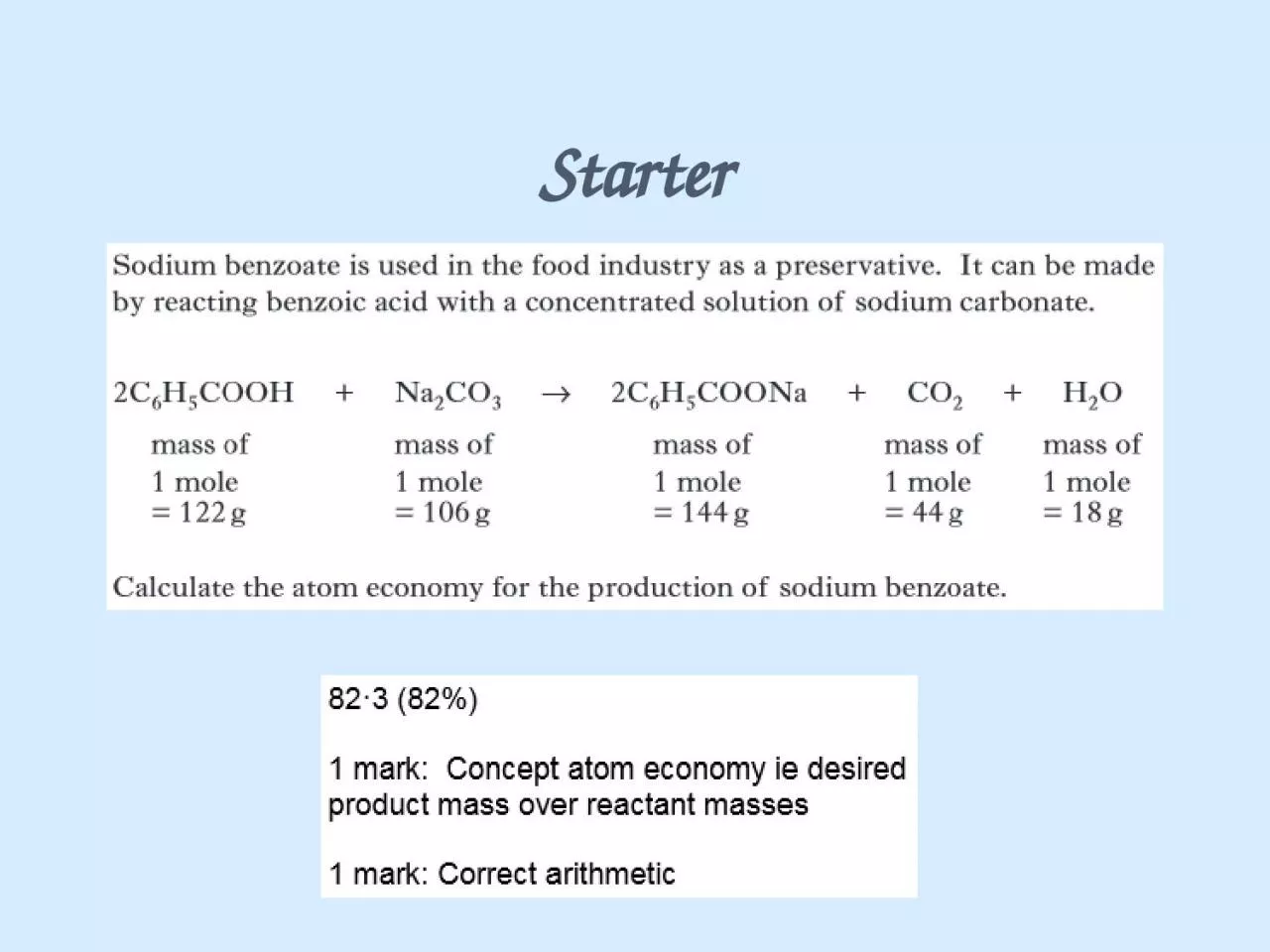

Learn how esters are named and identified and how to draw the structural formula of an ester Esters Alcohol Carboxylic Acid Ester Water Esterification Alkanoic acids reacting with Alkanols ID: 1026240
Download Presentation The PPT/PDF document "Starter a) Esters Learning intention" is the property of its rightful owner. Permission is granted to download and print the materials on this web site for personal, non-commercial use only, and to display it on your personal computer provided you do not modify the materials and that you retain all copyright notices contained in the materials. By downloading content from our website, you accept the terms of this agreement.
1. Starter
2. a) EstersLearning intentionLearn how esters are named and identified and how to draw the structural formula of an ester.
3. EstersAlcohol + Carboxylic Acid Ester + WaterEsterification, Alkanoic acids reacting with Alkanols.H+Esters have sweet smells and are more volatile than carboxylic acids.They are responsible for sweet fruit smells. 280 aromas make up a strawberry smell!! 3-methylbutyl ethanoate in bananas. 2-aminobenzoate is found in grapes. We imitate these smells by manufacturing flavourings. Esters are also used in perfumes. Esters can also be used as solvents in glues.Polyesters are used to make plasticisers.Methyl ester is a biodiesel.
4. Naming EstersSecond, find the C=O in the carboxylate group, this gives the 2nd word with the ending –oate. This comes from the acid.First, the 1st word comes from the alcohol. The name ends in –yl.ethyl propanoateCH3 CH2 COO CH2 CH3 C2H5COOC2H5R-OH + R’-COOH R’-COOR + WaterR-ylR’-oateFirstSecond
5. b) Making EstersLearning intentionLearn about how esters are formed by condensation reactions of carboxylic acids and alcohols.
6. Making EstersOne way of preparing esters is to condense an alcohol with a carboxylic acid: The reaction is slow at room temperature and the yield of ester is low. The rate can be increased by heating the reaction mixture and by using concentrated sulphuric acid as a catalyst. The presence of the concentrated sulphuric acid also increases the yield of ester.The aim of this experiment is to prepare an ester and to identify some of the characteristic properties of esters.
7. Ester formation+Condensation ReactionThe reaction is brought about by heating a mixture of a carboxylic acid and an alcohol with a little concentrated sulphuric acid. (which acts as aCatalyst and absorbs the water produced).methyl ethanoateCH3COOCH3 + H20RCOOREster linkROORCRCOHORHOHOH+CH3OHCH3COOH +ethanoic acidmethanol
8. Set up a water bath using a larger beaker and heating water until it boils. Turn off the Bunsen. Alternatively, boil some water in a kettle and pour it into the large beaker. Add the alcohol to a test tube to a depth of about 1 cm. To this add about the same volume of carboxylic acid. Add about 5 drops of concentrated sulphuric acid to the reaction mixture. Soak a paper towel in cold water, fold it up and wrap it round the neck of the test tube. Secure it with a rubber band. WHY?Place a loose plug of cotton wool in the mouth of the test tube. WHY? Place the test tube in the hot water bath. While the reaction mixture is being heated add about 20 cm3 of sodium hydrogencarbonate solution to the small beaker. After about 10 minutes, take the test tube from the water bath and remove the plug of cotton wool. Slowly pour the reaction mixture into the sodium hydrogencarbonate solution. WHY?Gently swirl the contents of the beaker and look to see if there is any sign of the ester separating from the aqueous mixture.
9. Esters are named by joining the name of the alcohol with the name of the acid.Ethanol + ethanoic acidEthyl ethanoatePropanol + ethanoic acidPropyl ethanoateButanol + ethanoic acidButyl ethanoateEthanol + propanoic acidEthyl propanoateEthanol + benzoic acidEthyl benzoate
10. Animation esterification
11. Starter
12.
13. c) Uses of EstersLearning intentionLearn about the many everyday uses of esters.
14. Uses of estersEsters are also used as non-polar industrial solvents.Esters are oily liquids with generally very pleasant fruity smells and have a range of uses.Many esters are used as flavourings and in perfumes. Esters are also used as non-polar industrial solvents.Some of the smaller esters are quite volatile and are used as solvents in adhesives, inks and paints – pentyl ethanoate is used in nail varnish for example.
15. c) Hydrolysis of EstersLearning intentionLearn how esters can be broken down by hydrolysis into the parent carboxylic acid and alcohol.
16. Hydrolysing EstersAlcohol + Carboxylic Acid Ester + WaterAlcohol + Carboxylic Acid Ester + WaterCondensationHydrolysisThe ester is split up by the chemical action of water, hydrolysis.The hydrolysis and formation of an ester is a reversible reaction.RCOORHOH+Bonds brokenEster + Water+RCOHORHOBonds formedCarboxylic Acid + Alcohol
17. a) Name the alcohol and carboxylic acid b) Name the ester